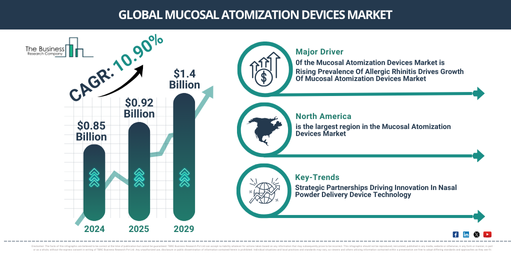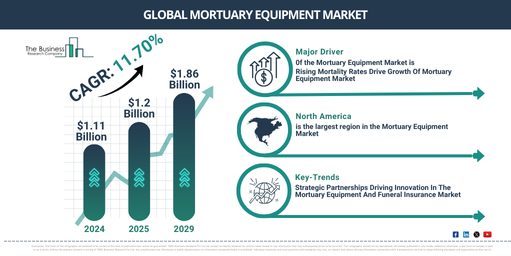Global Wearable Heart Monitoring Devices Market Opportunities And Strategies 2023
The Business Research Company’s global market reports are now updated with the latest market sizing information for the year 2023 and forecasted to 2032
The Business Research Company’s wearable heart monitoring devices market report forecasts the wearable heart monitoring devices market size to grow to $3.43 Billion by 2027, with a CAGR (compound annual growth rate) of more than 11%.
Learn More On The Wearable Heart Monitoring Devices Market Report 2023 – https://www.thebusinessresearchcompany.com/report/wearable-heart-monitoring-devices-global-market-report
Wearable Heart Monitoring Devices Market Size Forecast
The global wearable heart monitoring devices market is expected to grow from $1.95 billion in 2022 to $2.19 billion in 2023 at a compound annual growth rate (CAGR) of 12.3%. The Russia-Ukraine war disrupted the chances of global economic recovery from the COVID-19 pandemic, at least in the short term. The war between these two countries has led to economic sanctions on multiple countries, a surge in commodity prices, and supply chain disruptions, causing inflation across goods and services and affecting many markets across the globe. The global wearable heart monitoring devices market size is expected to reach $3.43 billion in 2027 at a CAGR of 11.8%.
North America held the largest wearable heart monitoring devices market share, and Asia-Pacific was the fastest-growing region in 2022.
Key Wearable Heart Monitoring Devices Market Driver – Increase In The Incidence Of Cardiovascular Diseases
According to the Centres for Disease Control and Prevention (CDCP), a US-based government agency, one person will die from cardiovascular disease every 34 seconds in the United States in October 2022. Furthermore, roughly 697,000 persons died from heart disease in the United States in 2020, with adults under the age of 65 accounting for two-tenths of CAD deaths. As a result, the rising prevalence of cardiovascular diseases (CVD) pushes the development of wearable cardiac monitoring devices.
Request for A Sample Of The Global Wearable Heart Monitoring Devices Market Report:
https://www.thebusinessresearchcompany.com/sample.aspx?id=9401&type=smp
Key Wearable Heart Monitoring Devices Market Trend – Technological Advancement
To strengthen their market position, major companies in the wearable heart monitoring device market are introducing innovative products with advanced technologies. For example, RhythMedix, a medical equipment manufacturer based in the United States, introduced the next-generation RhythmStar, a wearable cardiac monitoring gadget with built-in cellular communication technology, in February 2021. This new RhythmStar is a wearable device that allows for long-term remote monitoring without the use of a phone or other connectivity equipment. By alerting clinicians when a potentially deadly arrhythmia is discovered, the technology enables the company’s team of licenced professionals in the United States to promptly analyse and diagnose cardiac irregularities.
Wearable Heart Monitoring Devices Market Segment
1) By Device Type: Diagnostic And Monitoring Devices, Therapeutic Devices
2) By Product Type: Electric Pulse-Based Product, Optical Technology-Based Product
3) By Distribution Channel: Pharmacies, Online Channels, Hypermarkets
4) By Application: Sports And Fitness, Remote Patient Monitoring, Home Healthcare
Wearable Heart Monitoring Devices Market Major Players and Strategies
Major players in the wearable heart monitoring devices market are Medtronic Plc., Koninklijke Philips N.V., Boston Scientific Corporation, Johnson & Johnson Private Limited, Kinetic Products UK Ltd., Beurer GmbH, Medisana AG, Polar Electro Oy, Garmin Ltd., Baxter International Inc., Briggs Healthcare, Zimmer Biomet, 3M, Smith & Nephew Plc., Integra LifeSciences, Abbott Laboratories, and Stryker Corporation.
In January 2021, Boston Scientific, a US-based medical technology company, acquired Preventive Solutions for approximately $925 million. The acquisition will help Boston Scientific in increasing its reach in the heart diagnostics and services area. Moreover, with this acquisition, Boston Scientific expanded its business sector of core cardiac rhythm management and electrophysiology which in turn reinforced its position in this industry. Preventive solutions is a US-based company that manufactures wearable heart sensors for remote patient monitoring.
The Wearable Heart Monitoring Devices Global Market Report 2023 covers regional data on wearable heart monitoring devices market size, wearable heart monitoring devices market trends and drivers, opportunities, strategies, and wearable heart monitoring devices market competitor analysis. The countries covered in the wearable heart monitoring devices market report are Australia, Brazil, China, France, Germany, India, Indonesia, Japan, Russia, South Korea, the UK, and the USA, and the major seven regions are Asia-Pacific, Western Europe, Eastern Europe, North America, South America, the Middle East, and Africa.
A wearable heart monitor is a personal monitoring gadget that uses an electrical detecting band that wraps around the chest to capture and track heart rate. Its primary function is to capture heart rate data while participating in various forms of physical activities and other exercises.
View More Reports Related To The Wearable Heart Monitoring Devices Market –
Wearable Blood Pressure Monitors Global Market Report 2023
Wearable Injectors Global Market Report 2023
Wearable Medical Devices Global Market Report 2023
Contact us at:
The Business Research Company: https://www.thebusinessresearchcompany.com/
Americas +1 3156230293
Asia +44 2071930708
Europe +44 2071930708
Email us at [email protected]
Follow us on:
LinkedIn: https://in.linkedin.com/company/the-business-research-company
YouTube: https://www.youtube.com/channel/UC24_fI0rV8cR5DxlCpgmyFQ
Global Market Model: https://www.thebusinessresearchcompany.com/global-market-model
Found this article helpful? Share it on:



